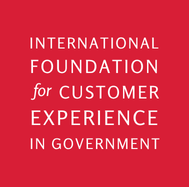The 4Ds+ Framework
A systemic, end-to-end cycle for CX management in government.
Overview of the 4Ds+ Framework
Extensive research by the Foundation has revealed that delivering excellent customer experience in the public sector requires a systemic approach. It also demands that organizations address the full, end-to-end cycle of CX management in government, ensuring that customer centricity becomes part of the organizational DNA, not a peripheral function or a one-off assignment delegated to a separate team.
The 4Ds+ Framework is now built on two interlinked components:

The 4Ds (Direction, Design, Development, Delivery)
These are the drivers of customer experience. They represent the internal capabilities, practices, and processes that shape how services are designed, developed, and delivered.

The Plus dimension
This represents results. It reflects the tangible outcomes of applying the 4Ds, as experienced by customers, staff, and the institution.
In other words, the 4Ds describe what organizations must do to create excellent customer experiences, while the Plus dimension captures what those efforts have achieved. The drivers and results are inseparable—strong performance in the 4Ds creates the conditions for strong results in the Plus dimension, and results data in turn informs how the 4Ds are refined and improved.
The 4Ds
The 4Ds+ Framework is now built on two interlinked components
Direction
Guides entities in assigning CX leadership, identifying CX priorities, and formulating a strategy grounded in current state and aspirations.
Design
Realises the aims defined in Direction through a customer-centric design process for priority services and life events.
Development
Translates service designs into digital and non-digital solutions to ensure feasibility and customer-centric outcomes.
Delivery
Brings your CX vision to life through customer-centric execution across all channels, ensuring consistent positive experiences.


The Plus dimension:
The Plus dimension focuses on demonstrating the actual outcomes of CX efforts, particularly over the last three years. It shifts the emphasis from intention (Direction and Design) and implementation (Development and Delivery) to tangible results experienced by customers, staff, and the institution. CX results are assessed through a triangulated lens, combining operational and perception perspectives. Organizations must provide evidence across four areas:
